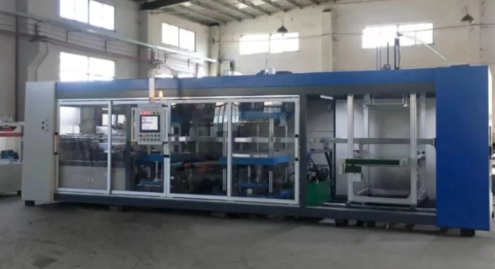Views: 0 Author: Site Editor Publish Time: 2025-09-23 Origin: Site
Are you looking for stronger, lighter panels? Twin Sheet Thermoforming is changing manufacturing. This guide explains the process and key benefits. You will learn applications, tooling, and design tips. Manufacturers can cut costs and speed production.
Twin Sheet Thermoforming is a process that joins two heated plastic sheets into a single, hollow panel. Both sheets are drawn into separate molds and pressure-welded at designated points. The result is a strong, lightweight, and seamless part. Unlike traditional vacuum forming, it eliminates the need for separate assembly of two sheets.
The process starts with clamping two plastic sheets in parallel frames. Each sheet is heated to its optimal forming temperature. Once heated, the sheets are drawn into their respective molds. Vacuum and positive air pressure help the sheets conform precisely. Finally, the molds press together at predefined points, bonding the sheets permanently.
| Feature | Twin Sheet | Injection Molding | Blow Molding | Rotational Molding |
|---|---|---|---|---|
| Tooling Cost | Low | High | High | High |
| Time-to-Market | 6-10 weeks | Months | Weeks | Months |
| Durability | High, hollow | High, solid | Moderate | Moderate |
| Weight | Light | Heavy | Moderate | Heavy |
| Design Flexibility | High | Limited | Limited | Limited |
| Finish Options | Multiple | Limited | Limited | Limited |
Tips: Twin Sheet Thermoforming combines speed and precision, ideal for double-sided components.
Draw Ratio: The ratio of sheet area to molded area; crucial for consistent thickness.
Secondary Draw: Additional stretching in complex shapes.
Platen Alignment: Ensures consistent welding between sheets.
Tooling: Often aluminum, machined or cast, providing precise shapes.
Twin Sheet Thermoforming is not just 'two vacuum-formed sheets glued together'. It produces a single, stronger part. It can replace processes like injection or blow molding for certain panels, saving cost and time.

By forming two sheets simultaneously, labor-intensive assembly steps are eliminated. Bolting, gluing, or screwing parts together becomes unnecessary, reducing production time.
Tooling development is simpler than injection molding, allowing production in just weeks. Parts reach the market faster, supporting rapid product launches.
Geometric strength in each sheet creates strong panels without additional reinforcement. Parts remain lightweight yet durable.
Tooling modifications are easier than with other molding processes. Inserts enable rapid style, logo, or model changes.
Twin Sheet Thermoforming tooling can cost up to 90% less than injection or rotational molds. Re-tooling is quicker, supporting product updates efficiently.
Tips: Evaluate tooling design early to maximize strength and reduce production delays.
Ideal for doors, hatches, and panels visible from both sides. This technology creates fully detailed exteriors without extra assembly.
Panels can house wiring, switches, locks, and electronic components securely. They maintain structural integrity while hiding components.
Thermal or acoustic insulation can be added between sheets, enhancing energy efficiency or noise reduction.
EMI/RFI shielding, pockets for manuals, and storage compartments are easily integrated. Twin Sheet Thermoforming offers custom solutions at lower costs than alternatives.
Tips: Design parts with clear end-use requirements to maximize value from twin sheet technology.
ABS and blends
HIPS
PC
PETG
ASA
HDPE
TPO
PVC alloys
Each resin has distinct durability, flexibility, and finish properties. Choice depends on environmental exposure, load-bearing needs, and aesthetics.
Top and bottom sheets can use different compatible resins for specific characteristics, such as heat resistance or impact strength.
Sheets typically range from 0.062" to 0.375". Draw ratios influence thickness uniformity, so secondary draws must be accounted for.
Parts can be painted, screen printed, hot-stamped, or left with inherent resin color. Surface textures can enhance aesthetics or functionality.
Tips: Test resin combinations to ensure consistent bonding and performance under operating conditions.
Machined aluminum molds offer precision, minimal warping, and improved texture definition. Cast aluminum can reduce cost but limits surface options.
Draft angles, corner radii, cutouts, and slots must be optimized. This ensures proper part formation and prevents thinning.
Platen pressure and alignment are critical. Clamps typically exert 10,000+ pounds to create a secure bond. Heat zoning ensures uniform sheet forming.
Trimming, routing, painting, screen printing, and assembly integration should be planned early. Robotic systems can enhance consistency. Maintain regular equipment calibration to preserve part quality and reduce rejects.
Large or complex parts require careful draw ratio management. Secondary draws can create thin areas. Proper tooling minimizes these issues.
Mold venting prevents trapped air. Compression points may cause visual shadows, which should be positioned in low-visibility areas.
Severe undercuts may require design adjustments. Pressure forming is limited in twin sheet operations.
Geometric strengthening reduces the need for additional supports. Evaluate loads to maintain durability without excess weight.
Parts must flex or expand without cracking. Resin selection and design features help compensate for environmental changes. Collaborate with engineers to balance strength, weight, and thermal expansion in design.
Lower tooling costs, faster modifications, and lighter parts favor Twin Sheet Thermoforming in many panel applications.
While durable, rotational molded parts are heavier and slower to market compared to twin sheet panels.
Blow molded parts have limited exterior detail and thickness control, making twin sheet methods preferable for complex panels.
For double-sided, lightweight, or insulated parts, twin sheet thermoforming often provides superior cost efficiency and design flexibility. Consider twin sheet thermoforming when both aesthetics and functionality are critical.
Twin Sheet Thermoforming offers faster production and cost savings. MINGDU provides precise machines for lightweight, strong parts. Their solutions enhance design flexibility and efficiency for manufacturers. Consider consulting MINGDU for tooling options and pilot runs.
A: Twin Sheet Thermoforming forms two plastic sheets into a single, strong, lightweight part using molds and heat.
A: The top and bottom sheets are heated, drawn into molds, then pressure-welded at specific points.
A: It reduces labor, speeds production, creates durable lightweight panels, and allows flexible design changes.